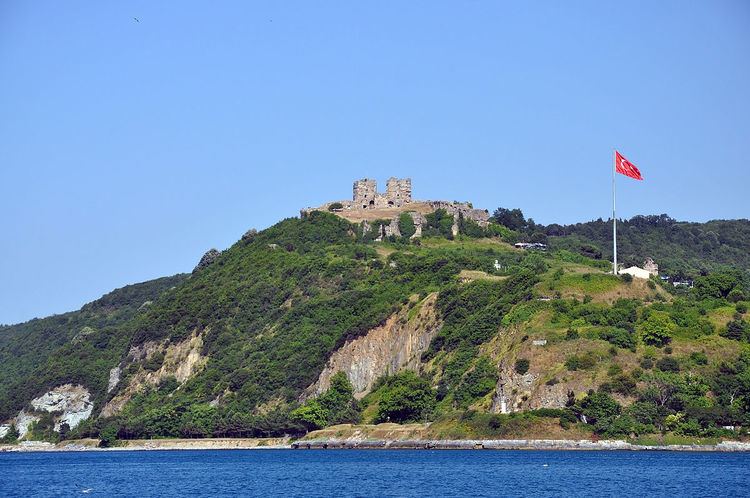 | ||
Similar Joshua's Hill, Rumelihisarı, Anadoluhisarı, Anadolu Feneri, TurkuaZoo | ||
Yoros castle istanbul turkey
Yoros Castle (Turkish: Yoros kalesi) is a Byzantine ruined castle at the confluence of the Bosphorus and the Black Sea, to the north of Joshua's Hill, in Istanbul, Turkey. It is also commonly referred to as the Genoese Castle, due to Genoa’s possession of it in the mid-15th century.
Contents
- Yoros castle istanbul turkey
- Yoros castle
- Geography
- History
- Present Day Yoros Castle
- Anadolu Kava
- References
Yoros castle
Geography
Yoros Castle sits on a hill surrounded by steep bluffs overlooking the Bosphorus. It is just north of a small fishing village called Anadolu Kavağı, on Macar Bay, and the entire area is referred to as Anadolu Kavağı. This section is one of the narrowest stretches of the Bosphorus, and on the opposite shore sits an area called Rumeli Kavağı, which formerly held a fortification similar to Yoros Castle. (Anadolu and Rumeli were Ottoman terms for the Anatolian and European parts of the empire).
History
Strategically set near the confluence of the Bosphorus and the Black Sea, the future site of Yoros Castle was settled by the Phoenicians and Greeks prior to the Byzantine period for trading and military purposes. The Greeks called the area Hieron (Sacred Place). The remains of temples, including Dios, Altar of the Twelve Gods, and Zeus Ourios (Zeus, granter of fair winds) were discovered in the area, dating to centuries BCE.
Yoros Castle was intermittently occupied throughout the course of the Byzantine Empire. Under the Palaiologos dynasty during the decline of the empire, Yoros Castle was well fortified, as was the Rumeli Kavağı on the opposite side of the Bosphorus. A massive chain could be extended across the Bosphorus between these two points, cutting off the straits to attacking warships, similar to the chain across the Golden Horn which was used to defend Constantinople during the last Ottoman siege by Sultan Mehmed II.
Byzantines, Genoese, and Ottomans fought over this strategic fortification for years. It was first conquered by Ottoman forces in 1305, but retaken by the Byzantines shortly thereafter. Bayezid I took the castle again in 1391 while preparing for his siege of Constantinople. It was used as his field headquarters during the construction of Anadoluhisarı, one of the more important castles for the siege. In 1399 the Byzantines attempted to take back Yoros Castle. The attack failed, but the village of Anadolu Kavağı was burned to the ground. The Ottomans held the fortress from 1391–1414, losing it to the Genoese in 1414. The forty-year Genoese occupation lent the castle its moniker of Genoese Castle.
Upon Sultan Mehmed II’s conquest of Constantinople in 1453, the presence of the Genoese at such a strategic location posed a threat to the new Ottoman capital. Within a few years, Sultan Mehmed drove the Genoese out. He then fortified the walls, and constructed a customs office, quarantine, and check point, as well as placing a garrison of troops there. Bayezid II (1481–1512) later added a mosque within the castle walls.
Cossack raids had plagued the Ottoman Empire throughout its long history. In 1624 a fleet of 150 Cossack caiques sailed across the Black Sea to attack towns and villages near Istanbul. They struck villages inside the Bosphorus, and Murad IV (1623–1640) refortified Anadolu Kavağı to defend against the fleet. It would prove instrumental in securing the region from seaborne Cossack raids.
Under Osman III (1754–1757), Yoros Castle was once again refortified. Later, in 1783 Abdülhamid I added more watchtowers. After this period, it gradually fell into disrepair. By the time of the Turkish Republic, the castle was no longer used.
Present Day Yoros Castle
The ruins of the citadel and surrounding walls still exist, though the mosque, most of the towers, and other structures are gone. Yoros Castle and the village of Anadolu Kavağı are a popular day trip from Istanbul. Normally, the site is not supervised and visitors are free to climb all over the ancient walls. However, there are currently archaeological excavations going on and visitors are unable to enter the castle. Greek inscriptions remain etched on the walls of the castle to this day, along with the symbol of the Palealogus family, who ruled Byzantium until its fall. The military importance of the site cannot be overstated. In fact, much of the area surrounding Yoros Castle is today in the hands of the Turkish military, who have closed off areas to visitors.
Anadolu Kavağı
The villagers of Anadolu Kavağı historically depended mostly on fishing for income, but it appears some may have acted as 'wreckers'. Turkish rumors report that they would light fires in order to disorient ships and ground them in the narrow straits, seizing their goods. Conversely, many claim that Anadolu Kavağı was also used as a shelter for trade ships against storms, where it is recorded even up to three hundred ships were serviced at a time.
